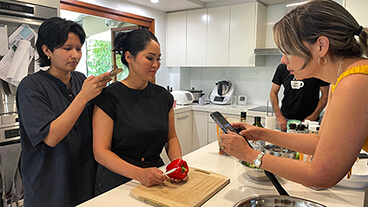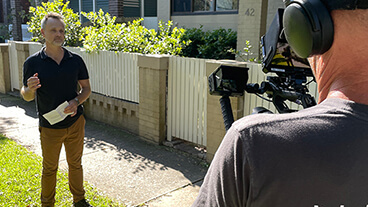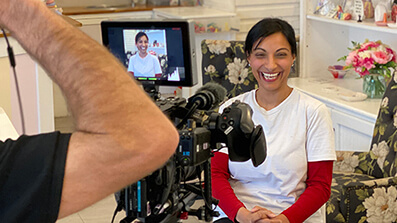As tech gets more affordable, businesses get more digital savvy and the pressure on bottom lines cut ever harder, many more of our clients are exploring making their own video content.
And rather surprisingly we’re totally supportive of their plans.
After all, any video – even the DIY low-fi sort – has a place as part of an overarching video marketing strategy. And if you’ve got one or more team members willing and able to ideate, shoot and edit, then what’s not to like about it?
What’s in it for you?
Video is a highly effective marketing tool that wins hands-down over other forms of content. It can be used on your website, on socials and in email marketing to your data base; it can even be played at presentations, pitches and at events.
Video is truely a cross platform medium.
Audience love video too. It’s an attention grabbing, easy-to-watch device that delivers good understanding and message recall.

And from a business perspective, it helps you to communicate information at volume, develop and show off your brand personality and demonstrate your expertise in the industry.
Plus it works 24/7 and by increasing dwell time on your website, can improve SEO and boost your ranking and move viewers from awareness of your brand through to paying customers and loyal brand fans.
In short it can escalate and improve your engagement and reach and make you more money.

When should you do it?
There’s never a bad time to start creating low fi video yourself. So in short you should start now!
However, the downfall of many organisations’ initial forays in DIY video, lie somewhere in between being overly-ambitious or complex ideas, and a clear lack of strategy.
This is something we find time and time again when training teams in video making: managers assume that within a few hours, everyone will become a professional videographer with broadcast-quality shooting and editing skills and can easily absorb the responsibility within their already jam-packed roles.
Sadly this just isn’t possible.
Making good video takes time both to learn and to practice, and success rarely comes overnight.
Instead, a better approach if you’re intending to make in-house video, is to be realistic and patient. Be utterly clear about the purpose of each piece of content (eg drive traffic to website, increase newsletter sign ups etc) and keep it short and simple.
By all means step up production values and concepts. But wait for your team to build up their expertise and strike some wins before going full Netflix.
Skills aside, the best home for DIY video is not surprisingly on social media. Audiences are generally pretty accepting of low fi content – happy to consume authentic, in-the-moment video.

That said, they expect something in return for stopping their doom scrolling, and quickly move on if there is no immediate value for them. Value in this instance can be educational, funny or something with a wow factor, but it needs to deliver on promise.
How can you do it?
If your organisation is serious about in-house video, be strategic. Work out who has aptitude for video making and the capacity to add it to their day to day workload.
Invest in developing their skills and give them time to experiment, rather than rushing out to buy complicated and expensive equipment. This goes for all elements – logistics, filming and editing.
Good planning or pre-production will save time in the long run and ensure a more efficient project. Script videos, plan shots, create a storyboard and remember that two heads (and hands) are always better than one.
Equipment-wise, if you have access to a DSLR or video camera, either can be used, although the latter can be a bit more challenging for video than stills. But a relatively new smart phone is more than adequate for capturing sound and vision for in-house video production, subject to a few provisos:
- Ensure there’s adequate storage to capture video. Unless you’re creating a Netflix video, there’s little need to shoot in a data-hungry 4K format.
- To capture interviews or excerpts from employees or clients, consider a lapel mic to capture good quality directional sound. Rode’s plug-in lavalier mic or a cable-free wireless set up such as Wireless Go are your best bet.
- And avoid wobble cam by using a tripod to hold your shots steady.
Whatever technical solution you settle on, it’s not just the gear and set up that will determine the quality of your video, but the person behind – and in front of the camera.
A solo videographer wears many hats – director, producer and interviewer – and has to tell a story visually, control about narrative and instruct participants and action. Ways to make this easier include:

- Plan your video, the narrative and the shots you will need (always more than less) to tell your story
- Be creative in your use of shots by varying angles, direction and frame size, Move your body not just the camera (slow tedious pans are rarely a good idea anytime)
- When interviewing, ask questions that don’t just illicit a yes or a no answers, remind subjects to use your questions in their answer and “paint a picture with words”
- Give run up time for shots and answers, choose quiet locations and consider comfortable framing.
Post production is often the most time consuming part of the process, but there are ways to make this easier.
For social media, often it pays to use built-in platform software – Reels, Tic Tok and You Tube – for ease of use and access to awesome music and effects.
DIY editing requires technical and creative capacity as well as attention to detail and time. For this reason, many DIY and in-house video makers outsource this element of production. But if you can give responsibility for this to someone who has capacity and interest in developing their skill set in this area, it can reap dividends in terms of DIY content, re-versioning and fast-turnaround video.
Over time your production skill and capacity will improve and there are many ways to improve the quality and volume of your in-house video.
You might even choose to commission the likes of us to make one-off, high-end, long shelf-like professional brand video, (link to production) but when it comes to all the other stuff, it’s perfectly possible for you to go it alone.

Just reach out if you need some guidance and we can help get your in-house team on the video road.
You may also like :
In house vs outsourcing: what video production model is right for you?

